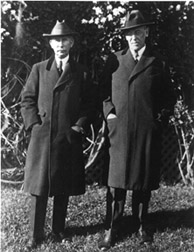![]()
In 1914, war broke out in Europe and, in time, involved countries from around the world. As the war progressed, a series of secret and complicated agreements among the allies, such as the Treaty of London 1915 or the Sykes-Picot Agreement 1916, began to set the basis for a postwar settlement. These agreements were all largely territorial in nature and provided for recognized territorial additions to the victors, for example, Russian control of the Straits.
Soon after the American entry into the war, Woodrow Wilson, the American President, revealed his idea for a peace settlement on 8 January 1918. The Fourteen Points included both idealistic ideas, such as "diplomacy shall proceed always frankly in the public view," and practical matters, for example, that Alsace-Lorraine should be "righted" or returned to France. (1) A key feature of Wilson's Points was his insistence on the creation of an international body to prevent war in the future. While Wilson was the first world leader to promote the idea, it soon had several versions, including those by France and Britain. Wilson had his advisor House develop the idea, and on 16 July 1918 Houses presented his plan to Wilson.
When Germany faced defeat in later 1918, the Germans sent a message for peace to Wilson. After somewhat complicated negotiations through the mail and by Colonel House, Wilson's special envoy, in person, on 12 October the Germans accepted Wilson's conditions.
The next step was to convene an armistice of the allies to set the final details. The initial body of power over the war was the supreme war council It was here that House was able to get the allies to agree on a plan. First, a pre-armistice meeting was convened at which House Wilson's representative was able to get the allies to agree with the French who were concerned with preventing the Germans from being a threat in the future, a security issue. The British were concerned with reparations, colonial matters and keeping their dominance of the seas. Under the Armistice agreement the Germans were to leave all "invaded territory [and] they were to not damage the infrastructure of the areas they left. The Germans did not view the armistice as a document of unconditional surrender but choose to instead see it in light of the earlier negotiations with House. The armistice was signed at 5 a.m. on 11 November 1918.
The allies next had to set the date and location of a peace conference. Representatives decided on Paris in January. Wilson decided to personally lead the American delegation, which consisted of Robert Lansing, the American Secretary of State, Colonel Edward Mandell House, an advisor of the president, General Tasker H. Bliss, the American representative on the Supreme War Council, and Mr. Henry White, a career diplomat and Wilson's only republican representative on the delegations.
When the conference opened, it quickly became apparent, that there were a number of competing concerns. For example, France was largely interested in the issue of security (the re-acquisition of Alsace-Lorraine and the demilitarization of the Rhine River Valley). The British wanted reparations for the damage done by the Germans to the allies and the punishment of war criminals. America wanted peace and the League of Nations to secure future peace. The Japanese wanted Germany's Pacific islands and the Chinese Shantung province. Italy also wanted territorial gain.
